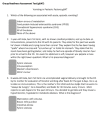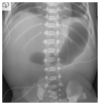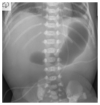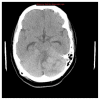Vomiting in Pediatric Patients
- PMID: 37465339
- PMCID: PMC10334445
- DOI: 10.21980/J8P363
Vomiting in Pediatric Patients
Abstract
Audience: This classic team-based learning activity is specifically designed for emergency medicine bound medical students and junior residents; however, general pediatrics residents and general medical students may also benefit from this activity. Senior residents and fellows felt that the cases were too basic for them but enjoyed acting as facilitators.
Introduction/background: Vomiting is a common chief complaint in pediatric patients seen in the Emergency Department. 1-3 Presentations include acute, chronic, and cyclic vomiting, with underlying etiologies such as toxin injection, emotional disturbances, and movement disequilibrium. 1 By understanding these various pathways, it is helpful for physicians to distinguish between gastrointestinal and non-gastrointestinal causes of vomiting. 1 Most cases of vomiting in the pediatric population are self-limiting and require only supportive treatment; however, physicians must be able to recognize red flags associated with vomiting that warrant further evaluation. 1,3 This task may be challenging for medical students and residents in emergency medicine and those with infrequent exposure to pediatric patients. Therefore, this team-based learning activity was developed to help junior learners in differentiating non-emergent and emergent cases of pediatric vomiting. This activity aids learners in formulating a differential based on age, history, and characteristics of vomiting. We also review specific causes of pediatric vomiting that physicians cannot miss including intussusception, pyloric stenosis, malrotation, intestinal atresia, and intracranial pathology.
Educational objectives: By the end of this TBL session, learners should be able to:Identify red flag symptoms that should prompt referral for urgent intervention by GI or surgical specialists.Recognize how chronicity of the vomiting can alter the differential diagnosisDescribe the varying pathways that can cause nausea and vomiting.Determine the necessity of imaging tests to confirm and possibly treat various causes of vomiting.Interpret imaging studies associated with specific causes of vomiting.
Educational methods: Classic Team Based Learning (cTBL).
Research methods: Learners and instructors provided verbal feedback after the session in a large group format. Learners were specifically asked if they felt the session was education, relevant, high-yield and level appropriate. One instructor provided written feedback to the cases as well.
Results: Overall learners and instructors found the session to be engaging, informative and educational. Learners felt that the session was level appropriate for medical students and junior residents. As a result of feedback from the session, several of the iRAT/gRAT questions were adjusted and the group application cases were re-written and implemented.
Discussion: Overall, the educational content and delivery was effective. This session was presented to a group of emergency medicine students, interns and residents. Learners were divided into smaller groups, and each group had a variety of level of learners, including pediatric emergency medicine fellows, present. The fellows, while not necessary to the delivery of the TBL, were extremely helpful in aiding the residents during the session. The final debriefing and answer review were essential to ensure that learners met all educational objectives and fully understood the materials.
Topics: Pediatric vomiting, intussusception, pyloric stenosis, intestinal atresia, malrotation, gastroesophageal reflux disease, superior mesenteric artery (SMA) syndrome, hyperemesis.
© 2020 Wray, et al.
References
-
- Gorelick M, Alpern E, Alessandrini E. A System for Grouping Presenting Complaints: The Pediatric Emergency Reason for Visit Clusters. Published June 28, 2008.Retrieved July 21, 2020 from https://onlinelibrary.wiley.com/doi/pdf/10.1197/j.aem.2005.03.530. - DOI - PubMed
-
- McIntosh M, Wylie T. Chapter 16: Emergencies in Infants and Toddlers. In: Adams JG, Barton ED, Collings JL, DeBlieux PM, Gisondi MA, Nadel ES, editors. Emergency Medicine: Clinical Essentials. 2nd ed. Philadelphia, PA: Elsevier; 2013. pp. 137–140.
LinkOut - more resources
Full Text Sources
Research Materials
Miscellaneous










